
The Oregon Commercial Historic District is a historic district in Oregon, Illinois, that has been listed on the National Register of Historic Places since 2006. The district is roughly bordered by Jefferson, Franklin, 5th and 3rd Streets in Oregon. It is one of six Oregon sites listed on the National Register and one of three to be so listed since the turn of the 21st century. The other two are the Oregon Public Library, listed in 2003, and the Chana School, listed in 2005.
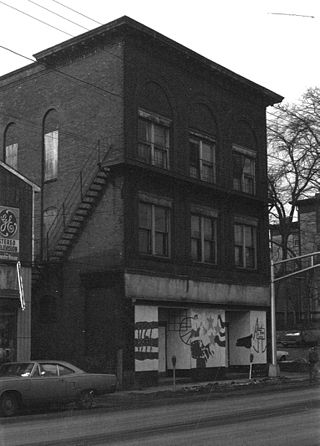
The Farnum Block was an historic commercial building located at 1 South Main Street, in Uxbridge, Massachusetts. It was a three-story brick building with Renaissance Revival styling, and was built sometime between 1895, when a fire destroyed commercial buildings in the area, and 1898. On October 7, 1983, it was added to the National Register of Historic Places. Sometime thereafter it was demolished.
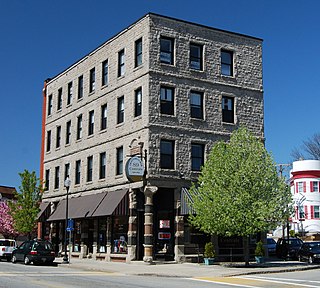
The Thom Block is an historic mixed-used commercial and residential building at 83-89 Main Street in Milford, Massachusetts. It is distinctive as being Milford's only building to be built out of locally quarried granite. The four-story building was built in 1891; its interior was gutted by fire shortly before its construction was completed. It originally housed three retail spaces on the ground floors, and two residential units on each of the upper floors.

The Franklin Block is a historic commercial building in Brockton, Massachusetts. The three-story brick Romanesque Revival-style building was built in 1888. Its construction marked the high point in the economic recovery of the city's Campello neighborhood, which had been devastated by fire in 1853, and is one of two 19th-century buildings in the area. The building was listed on the National Register of Historic Places in 1989.

The Armory Block is a historic commercial building at 39-45 Park Street in Adams, Massachusetts. Built in 1894-95, it is a fine example of Renaissance Revival architecture, and one of the town's most architecturally sophisticated commercial buildings. It served as the local National Guard armory until 1914, and now houses commercial businesses. It was listed on the National Historic Register in 1982.
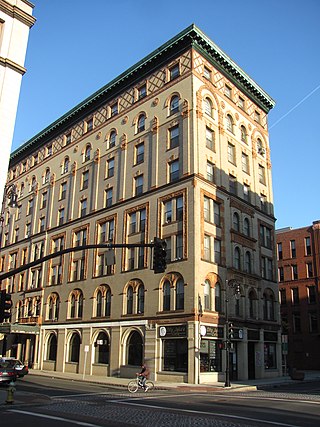
The Worthy Hotel is an historic hotel at 1571 Main Street in Springfield, Massachusetts. Built in 1895 and advertised as "Springfield's leading commercial and tourist house," the Worthy Hotel was Springfield's finest hotel until the opening of the Hotel Kimball in 1911. Located only two blocks south of Springfield Union Station and featuring 250 rooms, the Worthy Hotel's period of greatest significance was from 1895-1925. It was added to the National Register of Historic Places on February 24, 1983. It is historically significant not only for its commerce but for its Renaissance Revival architecture. Currently, the Worthy Hotel is an apartment building.

The Mills—Hale—Owen Blocks were a collection of three historic mixed-use commercial and residential blocks at 959—991 Main Street in the South End of Springfield, Massachusetts. They occupied an entire city block on the east side of Main Street, between Union and Hubbard Streets, and were some of the city's best examples of commercial Italianate architecture, prior to their destruction in the 2011 Springfield tornado. They were listed on the National Register of Historic Places in 1985.
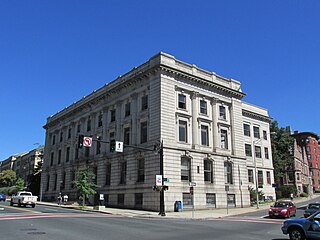
The Springfield Fire & Marine Insurance Co. is a historic commercial building at 195 State Street in Springfield, Massachusetts. Built in 1905 to a design by the renowned architecture firm Peabody and Stearns, it is a fine example of commercial Classical Revival architecture. It was listed on the National Register of Historic Places in 1983.
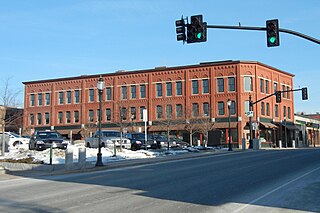
The Masonic Block is an historic commercial block in Reading, Massachusetts. This three-story brick building is distinctive in the town for its Renaissance Revival styling. It was built in 1894 by the local Reading Masonic Temple Corporation, and housed the local Masonic lodge on the third floor. The building was listed on the National Register of Historic Places in 1984.

The Worcester Five Cents Savings Bank is a historic bank building at 316 Main Street in Worcester, Massachusetts. The six story Romanesque Revival building was constructed in 1891 to a design by Stephen Earle. The building is unusual in downtown Worcester for its use of limestone and buff brick, and for its rounded corner bay. The building originally had plate glass and iron store fronts on its ground floor, but this was redone in matching limestone sometime after 1949.
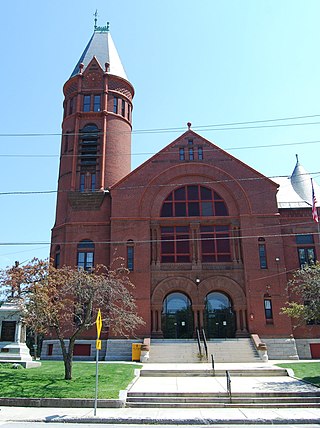
Southbridge Town Hall is an historic town hall at 41 Elm Street in Southbridge, Massachusetts. The imposing Romanesque Revival building was built in 1888 to serve as both the town hall and the public high school. It is the only major Romanesque building to survive in Southbridge. and was listed on the National Register of Historic Places in 1987.

The former Downing Street School, now the Traina Center for the Arts of Clark University, is a historic school building at 92 Downing Street in Worcester, Massachusetts. Built in 1891 to a design by Boston-based architect William Forbush, it is a high-quality local example of Romanesque Revival architecture. The building was listed on the National Register of Historic Places in 1980.
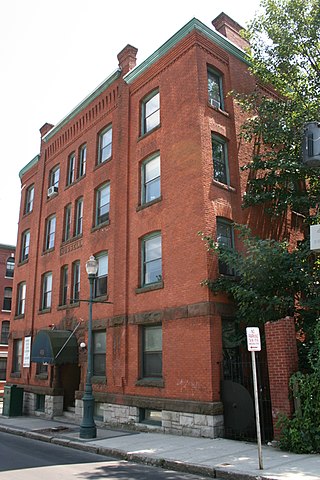
The Russell is an historic apartment house in Worcester, Massachusetts. Built in 1894, it is one of the few surviving apartment blocks, of many built, in the Main-Wellington-Chandler area, which had one of the city's highest concentrations of such buildings by 1900. The building was listed on the National Register of Historic Places in 1985.
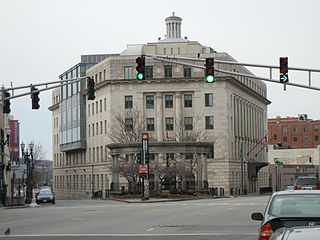
The Harold D. Donohue Federal Building and United States Courthouse, formerly known as the U.S. Post Office and Courthouse, is a courthouse of the United States District Court for the District of Massachusetts located in Worcester, Massachusetts.

Elbridge Boyden (1810–1898) was a prominent 19th-century American architect from Worcester, Massachusetts, who designed numerous civil and public buildings throughout New England and other parts of the United States. Perhaps his best known works are the Taunton State Hospital (1851) and Mechanics Hall (1855) in Worcester.
There are 112 properties and historic districts on the National Register of Historic Places in Worcester, Massachusetts, west of I-190 and the north–south section of I-290 and north of Massachusetts Route 122, which are listed here. Two listings overlap into other parts of Worcester: one of the 1767 Milestones is located in eastern Worcester, and the Blackstone Canal Historic District traverses all three sections of the city.
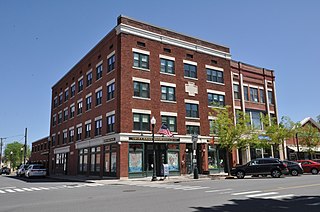
Benson's New Block and the Mohawk Chambers are a pair of mixed commercial and residential buildings at Main and Wells Streets in downtown Greenfield, Massachusetts. Built in 1913 and 1916, they are well-preserved and little-altered examples of period Neo-Classical commercial architecture. The buildings were listed on the National Register of Historic Places in 2014.

Cutting, Carleton & Cutting was an American architectural firm, with offices in Worcester, Massachusetts, active from 1895 to 1932.

The Duprey Building is a historic commercial building at 16 Norwich Street in downtown Worcester, Massachusetts. Built in 1926, it is a good example of a commercial Classical Revival building, built by a prominent local developer. The building was listed on the National Register of Historic Places in 1980. It is now mostly occupied by residences.

The Browne-Masonic Building is a historic commercial and fraternal organization building at 126-150 Pleasant Street in Malden, Massachusetts. Built in 1894, it is a good example of Classical Revival architecture, designed by the prominent Boston firm Hartwell & Richardson. The building from its inception served as a home for a variety of fraternal organizations, notably housing local Masonic organization for much of the 20th century. The four-story brick building now houses commercial space on the ground floor and residences in the upper stories. It was listed on the National Register of Historic Places in 2022.






















